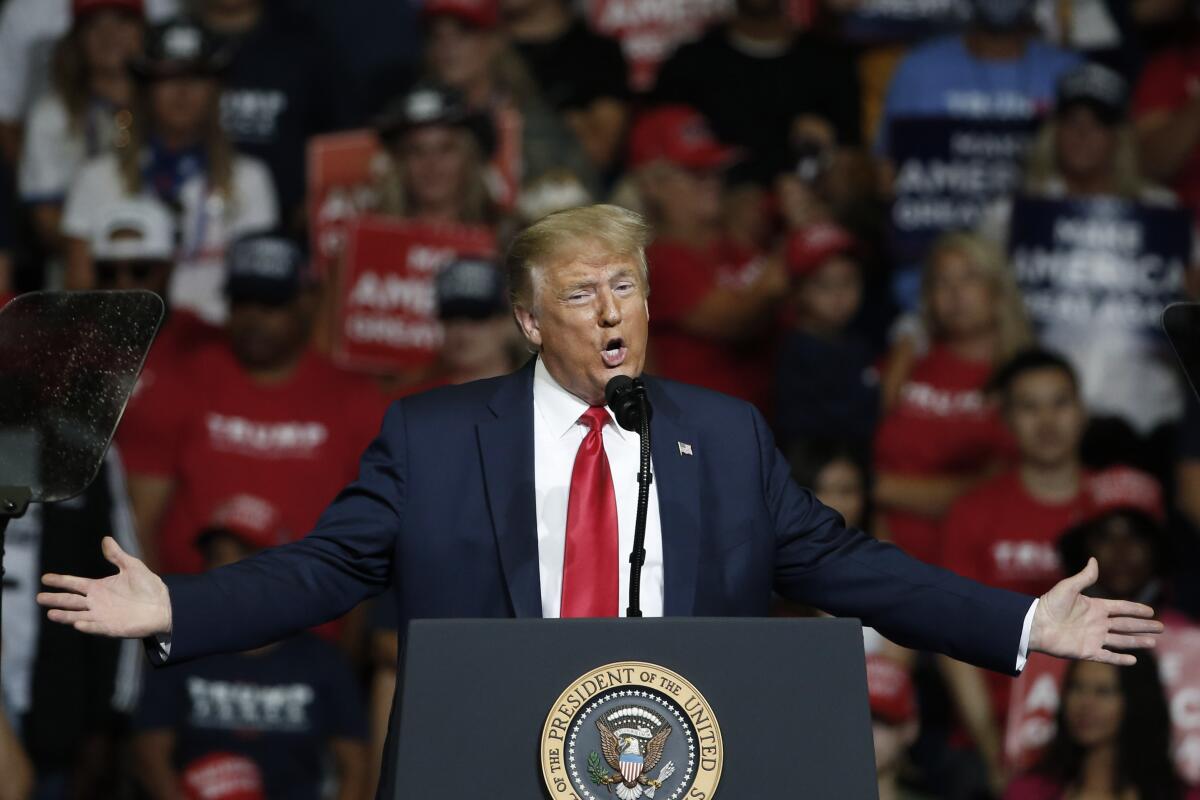Op-Ed: Even now, Trump still has approval ratings far higher than George Bush. Here’s why

A defining feature of the Trump presidency has been the seemingly rock-solid support of his partisan base. When Donald Trump declared at a January 2016 campaign event in Iowa that “I could stand in the middle of 5th Avenue and shoot somebody and I wouldn’t lose voters,” most observers took it as hyperbole.
Four and a half years later, the apparent imperviousness of Trump’s base to crisis after crisis has transformed this belief into received wisdom among political observers.
Indeed, in the face of withering criticism — even among some Republicans — of his management of the worst economic crisis since the Great Depression, the worst public health crisis since the Spanish flu and the largest protest movement in American history, Trump continues to enjoy 85% approval among Republicans in the latest Gallup poll.
Do the laws of political gravity simply not apply to this president?
Comparing Trump to George W. Bush, the last Republican president, shows how unusual this situation is. Trump’s approval rating among Republicans for the first half of 2020 is 91% compared with 69% Republican approval for Bush in the first half of 2008. If we compare approval ratings among Republicans for Bush’s entire second term with Trump’s first term, Bush’s average overall approval was about eight points lower than Trump’s average: 78% vs. 86%.
Indeed, Trump’s average support level among his fellow partisans is higher than for any president of either party since Eisenhower.
This incredibly high and stable Republican support helps account for Trump’s 46% average approval rating among all voters in 2020, which is far higher than Bush’s 30% average overall approval rating during 2008.
What explains Trump’s continued resilience within his party in the face of multiple simultaneous national and global calamities and a seemingly endless stream of political scandals?
The answer lies in a combination of factors. Unlike Bush, Trump never aspired to be “a uniter, not a divider.” His laserlike focus on appeasing his base at all costs has created a stability of support that carries on despite crises. His stoking political polarization helps him maintain that approval floor.
Critically, Trump’s presidency has come during a period of historically extreme partisan polarization. The partisan approval gap — the difference between Democratic and Republican approval — is larger for Trump than for any prior president.
The average gap of 78 percentage points during Trump’s presidency surpasses the approval gaps of 61 and 70 points during the Bush and Obama presidencies, respectively. This gap perhaps explains why a bipartisan group of experts surveyed by the Brookings Institution ranked Trump as the most polarizing president in American history.
Not only do Democrats and Republicans disagree over Trump’s performance to a greater extent than partisans in the past, they also dislike each other more than ever before. Political scientist Shanto Iyengar and his colleagues have documented the steady rise of so-called affective polarization over the past two decades.
At the same time, higher numbers of Republicans identify as conservative while more Democrats identify as liberal. This shift is apparent in Democratic support for Bush and Trump. Almost 31% of Democrats approved of Bush’s performance in his second term, down from 38% in his first term. The corresponding figure for Trump is less than 8%, another record.
Greater ideological polarization means fewer voters are willing to reassess their positions. This helps explain the unprecedented stability in support for Trump, regardless of other measures of his performance.
Among self-identified independents, Trump has a 35% first-term average approval rating (it is 39% in the latest Gallup poll). Approval among independents for Bush in his second term was only about 31%. Like their partisan counterparts, independents — who make up about 40% of the electorate — have remained remarkably consistent in their support for Trump.
What are the implications of this dynamic heading into the 2020 election? Democrats have little room to slide further in their support for Trump. And Republicans show they aren’t budging much either, with their support remaining near record highs.
While one can never rule out the effect of an October surprise, it seems fairly unlikely that Trump’s approval ratings will change dramatically in the next several months. More likely, he will remain roughly in the range he has occupied throughout his presidency, though support appears to be eroding in some segments such as among older voters and white women without college degrees.
Barack Obama’s 46% approval rating in June 2012 stands as the lowest June measure for an incumbent who was reelected since Harry Truman in 1948. Obama’s number eventually rose to 52% right before the 2012 election.
Now with Democrats and Republicans seemingly dug in, it appears that independent voters, to an even greater extent than in the past, will most likely determine the outcome of the election.
Matthew A. Baum is a professor of public policy at Harvard University’s John F. Kennedy School of Government.
More to Read
A cure for the common opinion
Get thought-provoking perspectives with our weekly newsletter.
You may occasionally receive promotional content from the Los Angeles Times.










